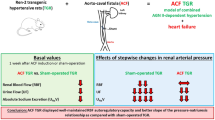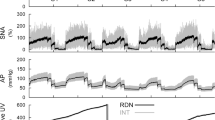Abstract
Angiotensin II has previously been reported to have in vivo and in vitro cardiac hypertrophic effects. We used the salt-sensitive Dahl rat genetic strain to separate mechanical (pressure overload) vs. hormonal (renin-angiotensin system) input in cardiac hypertrophy. Blood pressure was significantly increased and left ventricular hypertrophy, as indexed by LV/BW ratios, was present at 7 and 15 days in rats receiving 4% and 8% NaCl compared to the 1% controls. There was no effect of the angiotensin converting enzyme inhibitor, enalapril maleate, on lowering the blood pressure in 8% NaCl-treated animals, however, there was a significant reduction in LV/BW ratio in 8% NaCl-treated animals that received this drug. Left ventricular angiotensinogen mRNA activity was significantly reduced in rats receiving 4% and 8% NaCl. In this model of hypertension the cardiac hypertrophy which develops is largely dependent on mechanical forces though there remains a significant contribution to this process from either circulating or localized angiotensin II production. Regulation of angiotensinogen gene expression in the hypertrophied left ventricle suggests that volume and electrolyte control of angiotensinogen gene expression in the heart and/or hereditary factors are predominant in the control of regulation of this gene in the left ventricle of Dahl rats.
Similar content being viewed by others
References
Allen IS, Cohen N, Dhallan R, Gaa ST, Lederer WJ, Rogers TB: Angiotensin II increases spontaneous contractile frequency and stimulates calcium current in cultured neonatal rat heart myocytes: Insights into the underlying biochemical mechanisms. Circ Res 62: 524–534, 1988
Baker KM, Aceto JF: Characterization of avian angiotensin II cardiac receptors: Coupling to mechanical activity and phosphomositide metabolism. J Mol Cell Cardiol 21: 375–382, 1989
Baker KM, Campanile CP, Trachte GJ, Peach MJ: Identification and characterization of the rabbit angiotensin II myocardial receptor. Circ Res 54: 286–293, 1984
Baker KM, Singer HA: Identification and characterization of guinea pig angiotensin II ventricular and atrial receptors: coupling to inositol phosphate production. Circ Res 62: 896–904, 1988
Baker KM, Singer HA, Aceto JF: Angiotensin II receptormediated stimulation of inositol phosphates and cytosolic-free calcium in cultured chick myocytes. J Pharm Exp Ther 251: 578–585, 1989
Freer R, Pappano A, Peach M, Bing K, McLean M, Vogen S, Sperelakis N: Mechanism for the positive inotropic effect of angiotensin II on isolated cardiac muscle. Circ Res 39: 178–183, 1976
Baker KM, Chernin MI, Wixson SK, Aceto JF: Renin-angiotensin system involvement in pressure overload car diac hypertrophy in rats. Am J Physiol 259: H324-H332, 1990
Baker KM, Aceto JF: Angiotensin II stimulation of protein synthesis and cell growth in chick heart cells. Am J Physiol 259: H610-H618, 1990
Aceto JF, Baker KM: [Sar1] Angiotensin II receptor-mediated stimulation of protein synthesis in chick heart cells. Am J Physiol 258: H806-H813, 1990
Dahl LK, Heine M, Tassinari L: Role of genetic factors in susceptibility to experimental hypertension due to chronic excess salt ingestion. Nature 194: 480–482, 1962
Dahl LK, Heine M, Tassinari L: Effect of chronic salt ingestion. Evidence that genetic factors play an important role in susceptibility to experimental hypertension. J Exp Med 115: 1173–1190, 1962
Dahl LK, Knudsen KD, Heine MA, Leitl GJ: Effects of chronic excess salt ingestion. Modification of experimental hypertension in the rat by variations in the diet. Circ Res 22: 111–118, 1968
Iwai J, Dahl LK, Knudsen KD: Genetic influence on the renin-angiotensin system. Circ Res 32: 678–683, 1973
Jackson B, Johnston CI: The contribution of systemic hypertension to progression of chronic renal failure in the rat remnant kidney: Effect of treatment with an angiotensin converting enzyme inhibitor or a calcium inhibitor. J Hypertens 6: 495–501, 1988
Chomczynski P, Sacchi N: A single-step method of RNA isolation by acid guanidinium thiocyanate-phenol/chloroform extraction. Anal Biochem 162: 156–159, 1987
Rave NR, Crkvenjakov R, Boedtker H: Identification of procollagen mRNAs transferred to diazobenzyloxymethyl paper from formaldehyde agarose gels. Nucleic Acids Res 6: 3559–3567, 1979
Kafatos FC, Jones CW, Efstradiadis E: Determination of nucleic acid sequence homologies and relative concentrations by dot hybridization procedure. Nucleic Acids Res 7: 1541–1552, 1979
Lynch KR, Seminad VI, Ben-Ari ET, Garrison JC: Localization of preangiotensinogen messenger RNA sequences in the rat brain. Hypertension 8: 540–543, 1986
Jackson B, Fabris B, Paxton D, Franze L, Johnston CI: High salt diet ameliorates effects of angiotensin converting enzyme inhibition in spontaneously hypertensive streptozotocin diabetic rats. Clin Exp Pharmacol Physiol 17: 229–234, 1990
Author information
Authors and Affiliations
Rights and permissions
About this article
Cite this article
Peeler, T.C., Baker, K.M., Esmurdoc, C.F. et al. Angiotensin converting enzyme inhibition in Dahl salt-sensitive rats. Mol Cell Biochem 104, 45–50 (1991). https://doi.org/10.1007/BF00229802
Issue Date:
DOI: https://doi.org/10.1007/BF00229802




